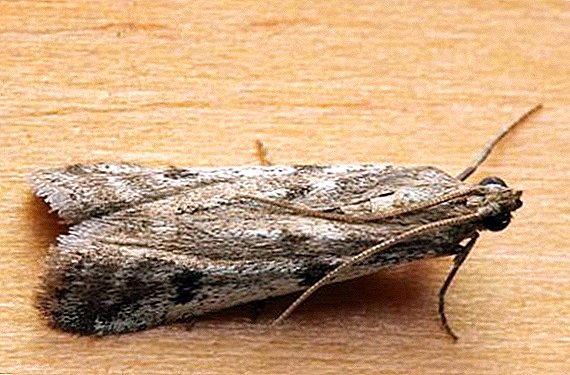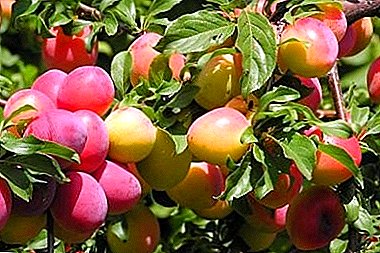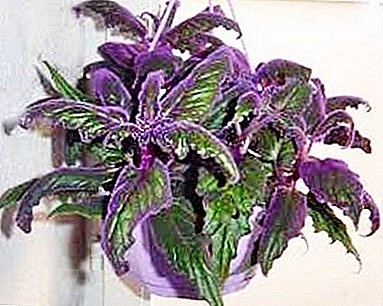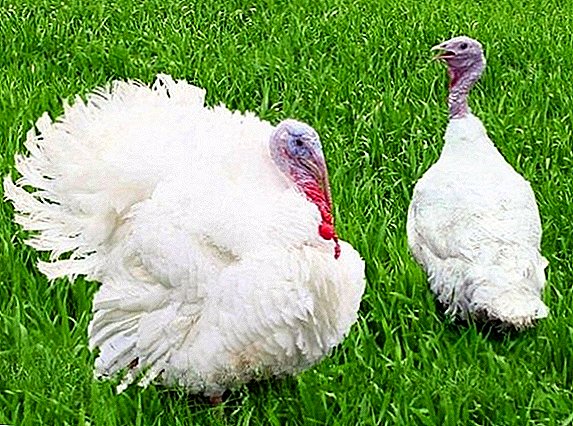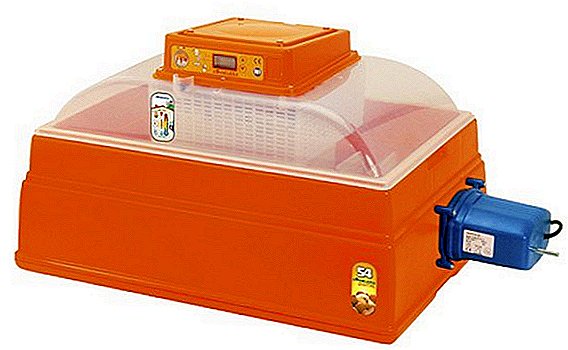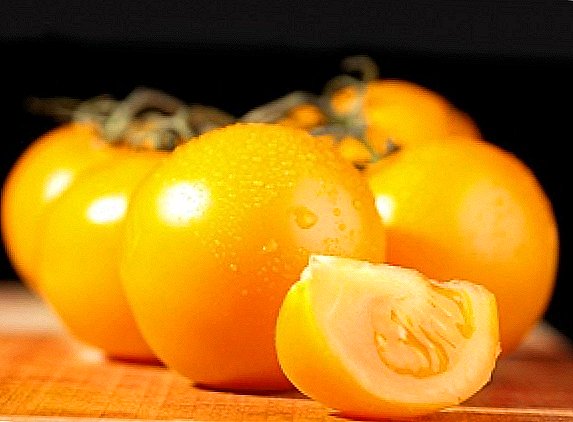
Yellow tomatoes, which in the Mediterranean called "Golden apples" fully justify their foreign name.
These bright, juicy fruits are able to show the wonderful taste of tomato culture no worse than the traditional red representatives.
Important is the fact that yellow tomatoes fit perfectly into the diet of allergies, while not causing any bad reaction.
It is in these tomatoes that such an antioxidant as lycopene is bound in a more suitable form for the human body than in red tomatoes.
In addition, the flesh of these yellow fruits contains a lot of carotene and organic acids, which makes this type of solanaceous culture very popular.
Sort "Lemon giant"

The ripening period of this variety is average - 120 days. Indeterminate bushes, grow to 1, 5 m. Above the seventh - ninth leaf the first brush will begin to form. The rest will alternate every 2 - 3 sheets.
The fruits are very large weighing up to 0.9 kg rounded at the bottom and flattened at the top, it tastes sweet. The flesh is very fleshy, the juice in it is almost absent.
In the brush is formed on average 3 large and 2 small tomatoes. The fruits themselves are yellow - orange, close in color to persimmon.
The yield is high and is about 5 kg per plant. These tomatoes make very tasty salads. They are good in canned form, as well as go for the manufacture of juice and sauces.
It’s usual to start a seedling from the beginning of March to the beginning of April. It is possible to replant in soil seedlings at least 50 days old.
The best time for dropping will be from the first half of May to the first half of June. On the unit area can be placed no more than 4 seedlings. Care seedlings ordinary.
Saplings will take root in any soil. If the weather conditions of the region are unstable, then it is better to cover young saplings until the weather normalizes, or the bushes do not get stronger.
Lead these bushes can not be in 1, but in 2 escape. Garter and pinching are required. Also need regular feeding with various fertilizer complexes.
Regular processing of bushes solutions of fungicides will prevent plants from being infected with various diseases, such as late blight, tobacco mosaic, etc. In general, the care of shrubs in this class is not much different from the care of most indeterminant tomato varieties.
It is also interesting to read about the varieties of tomatoes for open ground.
Variety "Persimmon"

The result of the work of amateur breeders. The variety is medium early, from the first shoots to the first harvest an average of 115-125 days passes.
The bushes are determinant, powerful, with a large number of leaves, grow up to 1 m in open ground and up to 1.5 m in the greenhouse. These bushes are recommended to grow it in greenhouses, but they also take root on the street. The leaves are large, light green.
Fruits are round, slightly flattened from above, rather large (the mass of the first fruits reaches 0.3 kg, the rest gain no more than 150 g). Sometimes such tomatoes grow, their weight exceeds 0.6 kg.
The color of the peel and the pulp is orange, on top, near the stem, a bright green spot is formed. Tomatoes themselves taste sweet, there is little seed in the pulp, as well as juice. One of the disadvantages of this variety is strongly change the taste of the fruit upon ripening. In this case, the pulp becomes fresh.
Also, the fruit has a hard rind that does not improve the taste. But these tomatoes are able to tolerate transportation. Do not spoil when stored in a dark, cool place.
The average yield is 3.5 kg from one plant. These tomatoes have a low amount of organic acids and a lot of carotene, so they can be considered an absolutely dietary product. They make good salads, tomatoes are suitable for preservation.
It is better to lay the seeds in the period from the end of March to the beginning of April. There should be a picking and proper care for the seedlings. Transplantation can be carried out from the middle of May into the greenhouse, and from the beginning of June into the open land. Ordinary planting scheme - 50x40-40 cm. At the unit of plozad, you can place no more than 3 seedlings.
It is imperative to conduct regular pinching of the bushes so that the stem near the bottom is the only one. Due to the impressive height of the plant, it is also necessary to tie up to facilitate the growth process for the bushes, and for itself - the harvesting process.
When strawling, it is advisable to remove the leaves, which create a shadow for the fruit. Otherwise, the sunlight will not fall on the tomatoes, and they will not ripen. Treatment with drugs and fertilizer fertilizer complexes are required. Watering should be timely and without interruption.
Grade "Königsberg Golden"

Was bred by amateur Siberian breeders. It is considered a medium early variety, begins to bear fruit after 105 - 110 days after the first shoots.
Suitable for normal soil, and for greenhouses, but still grows better in greenhouse conditions. Indeterminate shrubs, grow up to 2 m in height. Shoots tightly pressed to the center conductor. Inflorescences are formed after 1 leaf. In the brush forms up to 6 tomatoes.
Fruits are large, elongated, golden-yellow in color, sweet in taste. Sometimes there is a mild apple flavor in tomatoes. The second name of these tomatoes is "Siberian apricot". And dubbed him like that because high content of beta-carotene in the pulp, to make these fruits extremely useful.
Productivity is high, from one bush it is possible to collect about 2 - 3 buckets of tomatoes. This variety has proven itself both fresh and canned.
Bookmark seedlings need to produce in late March - early April. It should climb in 10 - 12 days.
Picks should be carried out after the appearance of two - three sheets. Rassad will benefit from the use of various growth promoters.
As containers for seedlings it is better to use peat cups, with which the bushes need to be instilled. In order for seedlings to take root, seedlings must be 60 to 65 days old before planting in open ground.
For greenhouse cultivation saplings may be younger. For seedlings of this variety is characterized by stretching the stalks of seedlings, and the leaves grow as if down, almost parallel to the stem. Therefore, when planting seedlings, it is better to set up not strictly vertically, but at an angle so that lateral roots form faster on the underground part of the stem. 3 seedlings per 1 sq.m. will be sufficient.
Special care, these bushes do not require. Plants just need to regularly fertilize, water, cultivate the soil beneath them, as well as remove weeds.
Bushes are high, so they must be tied up. This procedure is best done after two to three weeks after transplanting seedlings into the ground. When pinching, you can leave one side shoot to form a bush in two trunks. The normal load on the bush will be no more than 8 brushes.
Grade "Amber Cup"

Sredneranny grade, fructifies later 105 - 110 days after shoots. Suitable for greenhouses, and for open ground. Indeterminate shrubs, reach a height of 1.7 m. The brush is formed by four to five fruits.
Tomatoes are oval in shape, with smooth skin, dense flesh, weighing 85-125 g. The pulp of these tomatoes contains a lot of carotene and dry matter, sweet in taste, with plenty of juice.
These tomatoes do not deteriorate during transportation, and are also able to maintain their appearance and taste for 2 months after harvest.
Bushes and fruits calmly withstand high temperaturesand also are not affected by tobacco mosaic virus, verticillus and fusarium. Perfectly suited for consumption in raw form and for preservation.
Bookmark seedlings need to do 60 - 70 days before the proposed landing in the ground. Mandatory picks during the appearance of one or two sheets. Planting scheme - 3 - 4 seedlings per 1 sq. M.
Caring for seedlings should consist in its regular watering with a small amount of warm water, as well as in fertilization from time to time.
The variety is unpretentious. Bushes will be enough regular watering, removal of the side stepsons, except for one, so that you can form a bush with two stems, removing weeds, mulching, feeding, as well as a garter. All time frames and volumes of care items are similar to standards.
Variety "Peach"

Was bred by Chinese breeders. The variety is medium early, from the moment of laying the seeds to the first crop, an average of 110-111 days passes.
Bushes will take root both in hotbeds and in open ground. The plants themselves are determinant, they do not even reach 1 m in height.
At first glance it may seem as if the whole plant is dying, as the stem, the leaves, and even the fruit will sink to the ground. But this is typical for this variety, do not be alarmed.
Fruits are light yellow, can form a red blush on the side, plump as peaches are covered with hairs. The first fruits, as always, are the hardest (up to 150 g), and further reduced to 100 g. The taste is gorgeous, sweet. You can consume and fresh, and canned.
Need to start with seedlings. Sowing at the usual time - the end of February or the beginning of March. Transplant to open land after the end of frost. In the greenhouse can be transplanted before. Care for seedlings typical.
Be sure to arrange frequent feeding for seedlings, so that they gain strength before they prikopayut. Not important allow stretching of seedlings.
Be sure to stepchain bushes, otherwise the fruits simply do not have time to ripen. You need to form plants in one stem. It is also desirable garter bushes to make it easier to cover the soil with mulch and remove weeds.
Mulching plays a very important role, as the fruit can sink to ground level. And when they touch the ground, they can start to rot, so it will be better, they will ripen, for example, on straw.
Sort "Honey Spas"

Refers to mid-season varieties. It can be grown in greenhouses and in open land. It has time to ripen in 110 - 115 days. Indeterminate shrubs, in open ground reach 1.2 m, and in the greenhouse - 1.7 m.
Fruits are large and very large, some can reach 1 kg in weight. The shape of the tomatoes resemble the heart. The color of the fruit is very beautiful, honey-yellow, taste sweet, with spicy sourness.
This sort of tomato considered dietary suitable for people who are allergic to red tomatoes. Tomatoes are best consumed fresh, as in canned or pickled form they will not be very good. Tomatoes will not crack, and also they will not be affected by late blight.
The yield is high and is about 4 - 5 kg per plant.
Sowing seedlings is best done in early March, 50 to 60 days before the intended planting in the ground. The temperature for growing seedlings should be greater than 23 ° C. Care for seedlings standard.
Bringing in seedlings is best done in the second mid-April, although you can grow bushes in the greenhouse even earlier. Immediately after transplanting, it is necessary to drive in a support near each bush in order to facilitate growth for the bush. At one meter area can be planted no more than 3 seedlings.
Plant care ordinary. It is better to form bushes in 2 - 3 stalks to get more yield. Due to the rather impressive height of the bushes must be tied to a support.
Regular fertilizing with various mineral fertilizer complexes will also benefit the plants so that the crop will exceed all expectations. The resistance of the variety to phytophthora does not preclude infection, therefore, it is necessary to regularly treat plants with drugs.
You will be able to grow beautiful yellow tomatoes, the consumption of which will definitely benefit you. Work a little on the site, harvest, and your body will respond to you with gratitude to fresh and organic vegetables.




